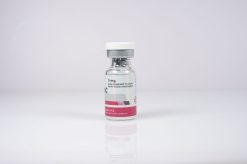Semaglutide 5mg
$150.00 Original price was: $150.00.$110.00Current price is: $110.00.
- Name: Semaglutide is known as (2S)-N-[2-[(1S)-1-amino-4-methyl-2-oxobutan-2-yl]amino]carbonyl-4-(4-fluorophenyl)-N-[(2S)-2-[(1S)-1-(4-fluorophenyl)-2-oxo-4-(trifluoromethyl)-1H-imidazol-5-yl]acetyl]-L-phenylalanine.
- Structure: It is a GLP-1 analog with a modified structure to enhance its stability and half-life.
- Uses: Primarily for managing type 2 diabetes and promoting weight loss, while also providing cardiovascular benefits.
- Dosage: Typically started at 0.25 mg once weekly, with possible increases to 0.5 mg, 1 mg, or 2 mg.
- Administration: Administered via subcutaneous injection using a syringe or pen, making it convenient for self-use.
- Storage: Store in the refrigerator before opening; after opening, it can be kept at room temperature for up to 28 days.
Categories: Beligas, Fat Burners, Mix Steroids, Peptides
Mechanism of Action:
Semaglutide works by mimicking the action of the GLP-1 hormone in the body. Here’s how it functions:
- Increases Insulin Secretion:
Semaglutide stimulates the pancreas to release insulin in response to meals, which helps lower blood sugar levels. - Decreases Glucagon Secretion:
It suppresses the release of glucagon (a hormone that promotes the release of glucose from the liver), which helps reduce the liver’s sugar output, particularly during fasting. - Appetite Regulation:
By acting on the brain’s appetite-regulating centers, Semaglutide reduces feelings of hunger and increases feelings of fullness, leading to a decrease in overall caloric intake. - Slows Gastric Emptying:
Semaglutide slows the rate at which food leaves the stomach, which prolongs satiety (the feeling of fullness) and helps control hunger.
These combined effects contribute to weight loss, improved blood sugar regulation, and reduced risk of complications associated with type 2 diabetes.
Common Uses:
- Weight Loss (Off-Label Use):
Semaglutide 5mg has become increasingly popular as a treatment for obesity. Clinical studies have demonstrated that Semaglutide can lead to significant weight loss by reducing appetite and improving calorie control. It is typically used in combination with a reduced-calorie diet and increased physical activity. - Type 2 Diabetes Management:
For individuals with type 2 diabetes, Semaglutide helps manage blood sugar levels. By improving insulin sensitivity and reducing glucose production by the liver, it supports long-term glucose control and reduces the need for other diabetes medications. - Cardiovascular Health (Off-Label):
Some studies have indicated that Semaglutide may have cardioprotective effects by reducing the risk of cardiovascular events in individuals with diabetes or those at risk. It can help reduce blood pressure and improve lipid profiles in some patients.
Dosing Guidelines:
Men & Women:
Initial Dose:
- The typical initial dose is 0.25mg once a week via subcutaneous injection (preferably in the abdomen or thigh).
- This initial dose is given for 4 weeks to allow the body to adjust to the medication.
Maintenance Dose:
- After the first month, the dose is typically increased to 0.5mg weekly for 4 weeks.
- If further weight loss or blood sugar control is desired, the dose can be increased to 1mg weekly.
- The maximum dose is 1mg weekly, but some individuals may require adjustments based on individual tolerance and goals.
Adjustment of Dose:
- Dosage adjustments are typically made in monthly increments, with gradual increases to minimize the risk of side effects. Always follow your healthcare provider’s recommendations for dose adjustments.
Administration:
- Semaglutide 5mg is injected subcutaneously (under the skin) once a week. It can be administered using a pre-filled pen or vial (if provided).
- The injection can be given at any time of the day, regardless of meals. The injection sites should be rotated to reduce irritation.
Side Effects:
Gastrointestinal Side Effects:
- Nausea: One of the most common side effects, especially during the initial stages of treatment. This usually subsides over time as the body adjusts.
- Vomiting and Diarrhea: Some users may experience upset stomach, vomiting, or diarrhea, particularly at higher doses.
- Constipation: In some cases, Semaglutide may cause constipation, although this is less common than diarrhea.
Endocrine/Metabolic Side Effects:
- Hypoglycemia (Low Blood Sugar): While Semaglutide itself is not likely to cause low blood sugar, it may increase the risk of hypoglycemia if used with other antidiabetic medications (e.g., insulin or sulfonylureas).
- Thyroid Issues: There have been concerns about thyroid tumors in animal studies, but the risk in humans is considered low. It is still recommended to monitor for any unusual symptoms, such as a lump in the neck or difficulty swallowing.
Cardiovascular Side Effects:
- Increased Heart Rate: Some individuals may experience a mild increase in heart rate, especially at higher doses, although this is generally not significant.
Injection Site Reactions:
- Redness, Itching, or Swelling: As with many injectable medications, some users may experience mild irritation at the injection site, which usually resolves on its own.
Other Side Effects:
- Fatigue: Some users report feeling tired or fatigued, especially early in treatment.
Cycle Length:
- Weight Loss Cycle: Semaglutide 5mg is typically used in long-term cycles for weight management, with many individuals continuing the medication for 6 months to 1 year. Monitoring by a healthcare provider is essential for ongoing efficacy and safety.
- Diabetes Management: For patients with type 2 diabetes, Semaglutide is often used indefinitely, as it helps manage long-term glucose levels and reduces the risk of complications.
- Discontinuation: Discontinuing Semaglutide should be done under the guidance of a healthcare provider, especially for individuals using it for weight loss or diabetes management.
Stacking Options:
- With Diet and Exercise (for Weight Loss): Semaglutide is most effective when combined with a caloric deficit diet and regular exercise. This combination will maximize the fat-burning effects and help maintain muscle mass during weight loss.
- With Other Weight Loss Agents: For enhanced results, Semaglutide may be stacked with other weight loss compounds like liraglutide, orlistat, or phentermine (under medical supervision).
- With Insulin (for Diabetes Management): Semaglutide can be combined with insulin for improved blood sugar control, though care must be taken to avoid hypoglycemia.
Related products
Sale!
Peptides
Sale!
Peptides
Sale!
Sale!
Beligas
Sale!
Peptides
Sale!
Sale!
















